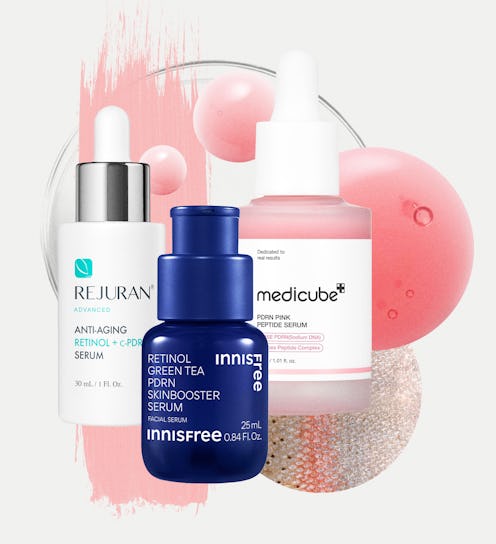(Back To Basics)
Salmon Sperm Is The Questionable Skin Care Ingredient Worth The Hype
Also known as PDRN.

Every now and again, beauty enthusiasts everywhere seem to become enamored with a trendy new skin care ingredient that sounds equal parts bizarre and intriguing. Snail mucin had its moment in 2023, and then it was dragon’s blood (which isn’t nearly as extreme as it sounds).
In the last year, the commentary surrounding PDRN — known more formally as polydeoxyribonucleotides — has been nearly impossible to escape, and that can honestly be attributed to a few different things. For starters, the colloquial name for PDRN is “salmon sperm,” which is already enough to raise some eyebrows. It’s also the active ingredient in an in-office facial treatment touted by both Kim and Khloé Kardashian, as well as Jennifer Aniston, all three of whom have admitted to trying it out in hopes of giving themselves a more youthful appearance.
These days, you can find PDRN in dozens of over-the-counter serums and creams that promise a long list of benefits including an increase in collagen production, bouncier, more hydrated skin, and a strengthened skin barrier.
Still a little taken aback by the “salmon sperm” of it all? TZR spoke to two board-certified dermatologists to get answers to your burning questions about PDRN, including what it is, who should use it, and how to add it to your skin care routine.
What Is PDRN?
PDRN is an abbreviation for polydeoxyribonucleotides (say that three times fast), which are, essentially, short chains of amino acids. “Polydeoxyribonucleotides are fragments of DNA (deoxyribonucleic acid),” explains Dr. Brendan Camp, M.D., double board-certified dermatologist at MDCS Dermatology in New York City. “These molecules carry genetic information. When used in skin care, PDRNs are thought to affect cellular functions through their interaction with cellular receptors.”
According to Dr. Joshua Zeichner, M.D., director of cosmetic & clinical research in dermatology at Mount Sinai Hospital in New York City, PDRN is typically derived from salmon (and trout) sperm, the extracts of which have been researched and shown to promote hydration, elasticity, and the reduction of wrinkles, and texture, among plenty of other benefits.
Who Should Use Topical PDRN Skin Care Products?
In general, PDRN is safe to use on all skin types, but experts say that it’s particularly great for people who want to address concerns like aging, dullness, and dehydration. “Products containing PDRN are attracting attention because of their associated benefits, such as improved collagen production, enhanced skin elasticity, a reduction in inflammation, and repair of UV-related damage,” Camp says.
How To Use PDRN In Your Skin Care Routine
PDRN is mostly used in in-office treatments, as it’s the main ingredient in the viral salmon sperm facial, during which Rejuran is injected into the face and neck or applied topically after microneedling. It’s important to note that PDRN isn’t FDA-approved for injection in the U.S., but some providers are doing it off label. “In-office treatments, which often use PDRN sourced from salmon sperm, are generally thought to be more effective and work faster than over-the-counter products containing PDRN,” says Camp.
It’s also popping up as a featured ingredient in topical serums that can be used to address the aforementioned issues over time, but per Zeichner, you’re more likely to see faster results if you combine it with a treatment like microneedling. “In microneedling, tiny holes are created in the skin, which provide a pathway to penetrate through the outer skin layer,” he says. “Ultimately better penetration should translate into a more effective treatment.”
That said, Zeichner doesn’t recommend combining over-the-counter, topical PDRN serums with at-home microneedling devices, since these serums are designed specifically for topical application, not injection. “Deep penetration into the skin, theoretically, could result in inflammatory reactions,” he explains.
There’s no bigger risk from incorporating a PDRN serum into your skin care routine than there would be with other kinds of serums, but you should always make sure to follow the instructions on the packaging for guidance on how and when to apply them.